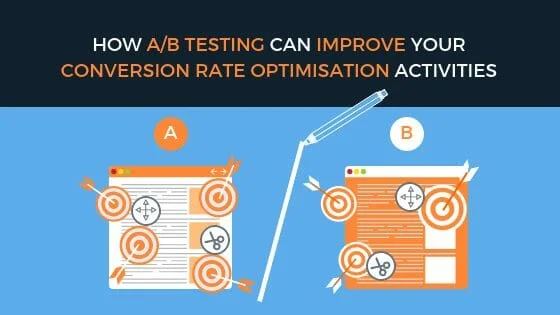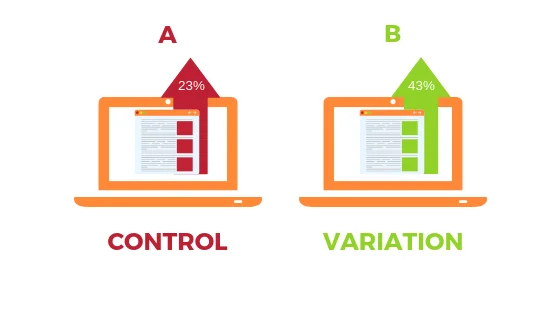
By Kelvin Sim
Introduction
Conversion Rate Optimisation (CRO) is the systematic process of making improvements to your website with the objective of increasing your conversion goals. As discussed in a recent blog post – How to Use Crazy Egg To Enhance Your Conversion Rate Optmisation Part 2 – Extracting & Analysing Data CRO involves understanding what your visitors on your website are looking for, their journey as they navigate through your website and the actions they take during their visit. More importantly, CRO also involves understanding what deterrents exists on your website to prevent them from completing your website goals.
In addition to CRO tools such as Crazy Egg, running A/B testing on your website can further enhance CRO activities.
What is A/B Testing
Website A/B Testing is an effective practice of showing two variants (or more) of the same web page to the same or different segment of visitors at the same time. It is essentially an experiment to determine which variant performs better for a given conversion goal.
The metrics for conversion are unique to each website. As mentioned in a previous blog post – Your Guide To Everything You Need To Know About Conversion Rates, these metrics (or goals), depends on your business structure.
For example, an E-commerce may be measuring the sale of a particular product, whilst for a media website it could be a subscription to their monthly newsletter.

A/B testing is an effective component to the overarching CRO process. But just how important is A/B testing?
Why A/B Testing
A/B testing allows you to make more informative web page changes that will enhance your conversion rates. It permits you to test any hypotheses about various elements on your web page and the impact it has on the user experience.
It is a safe and timely process that is both effective and enriching. Testing one change at a time helps you pinpoint the effects of this change instead of concluding on a total web page make over. Over time, this series of changes will provide a clear understanding of measurable improvements that will allow you to make crucial steps in a making a more effective marketing campaign.

For example, a popular photography principle that can also be applied to website is ‘The Rule of Thirds’. With this rule, you’re supposed to visually divide an image or web page into thirds both vertically and horizontally so that there are 9 equal squares, as seen below:
According to this rule, the four middle points typically where many would draw interest towards. In terms of web design, you can place the page’s most important elements at these intersections to capture attention and drive conversions.
However, this is one hypothesis and can only be proven correct if implemented. This is where A/B testing plays an imperative role. You can test any web page modifications without officially publishing your changes.
How A/B Testing Works / The Process of A/B Testing
A structured A/B testing program can make marketing efforts more profitable by pinpointing the most crucial problem areas that need optimisation. As previously mentioned A/B testing is a timely process and should always be done through a well-defined CRO process.
The process involves:
Identify Goals
![]()
Your conversion goals are the metrics that you are using to determine where or not the variation is more successful that the original version. As previously mentioned in a recent blog post – Your Guide To Everything You Need To Know About Conversion Rates, the conversion goals will depend on the type of business you have.
Research
![]()
Before you commence you’re A/B testing plan, you will need to conduct thorough research on the website is currently performing. This research can be done, but not limited to, with Google Analytics (GA) and CRO tools such as Crazy Egg. For more information on how to retrieve this data and information on user experience visit our recent blog post – 3 Easy Google Analytics Report To Help You Improve Your Conversions.
Both quantitative and qualitative research can help you prepare for the next step in the process which will be to develop some actionable observations and hypothesis.
Generate Hypothesis
![]()
At this stage, you should consider every bit of data collected from your web analytics software or CRO tools and analyse it to make some observations that will build the foundations to your hypotheses. Once you have you hypotheses ready, test it against various parameters that are relevant and important to your conversion goals.
Variation Creation
![]()
Make a variation based on your hypothesis. With A/B testing these tests should run against your existing web page – controlled version and the modified version – variable version. You can test multiple versions to see which works best.
Testing
![]()
At this point kick back and wait for visitors to navigate through your web page. At this stage your visitors will be randomly assigned to either the control of variation of your A/B testing. Their engagements will be measure, counted and compare between the two versions.
Analyse Results
![]()
In this final stage, you will find your campaign winner. But it doesn’t stop there. It is imperative you analyse your results because A/B is a continuous and timely process, run through the hypothesis you have generated for this test and ensure that it has achieved what it was configured for.
A/B Testing & Conversion Rate Optimisation
Before you can improve your CRO activities, you first need to figure out what deterrents currently exist on your web page. A/B testing provides a more conclusive understanding of how users navigate and interact with web page elements.
Paired with data from GA and visual data reports from your CRO tool, you will be able to develop a more grounded and data backed hypothesis that you strategically will make an impact on users’ behaviour that will drive conversion rates up.

For example, Amazon is at the forefront of conversion optimisation partly due to the scare they operate at and partly due to their immense dedication to providing the best customer experience. Amazon introduced ‘1-Click Ordering’ in the 1990s after much testing and analysis. The ‘1-Click Ordering’ let users make purchases without having going through the ‘add to shopping cart’ process. Once users click this feature, Amazon member’s billing and shipping details will automatically populate the ordering form and the shipping process will commence immediately. This had such a huge business impact that Amazon got it patented in 1999, however it is now expired.

This example demonstrates that through effective research and testing, only then will you be able to implement changes that will contribute to your CRO activities.
Conclusions
Many digital marketing efforts are geared towards driving traffic to a website, but as traffic acquisition becomes more difficult and expensive it is highly recommended that you have in place a website provide your traffic the best experience. A/B testing can help you run a series of changes that will allow you to make more informed decisions with your CRO activities. The insights drawn from A/B testing will then improve user experiences and ultimate increase conversion rates.









